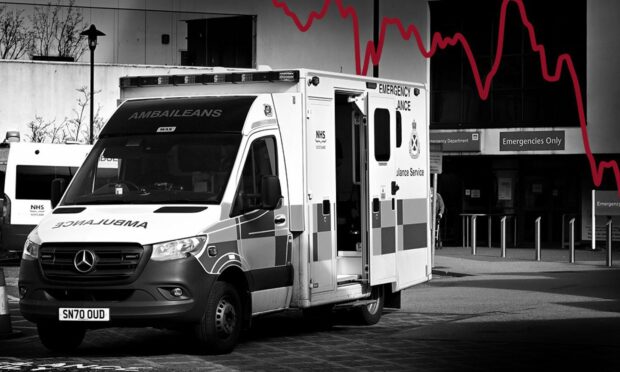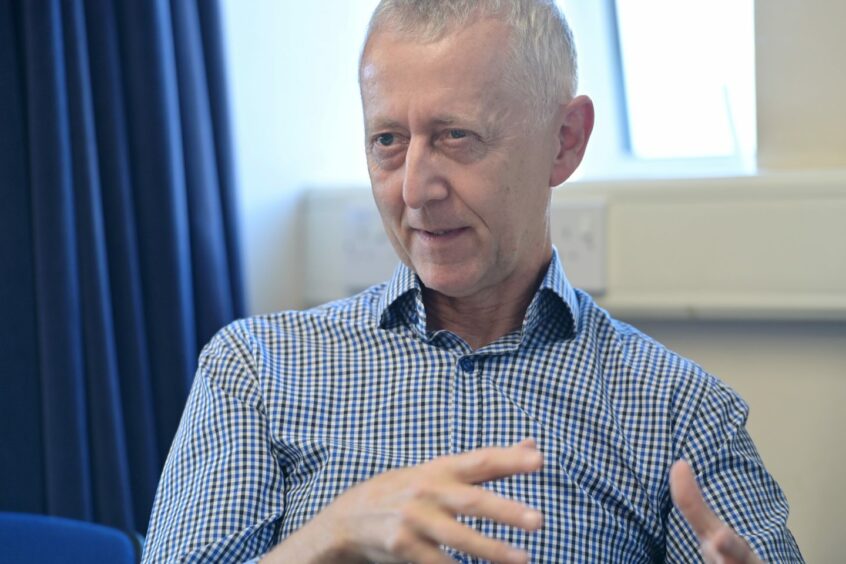Friday and Saturday nights are often thought of as the busiest periods at the emergency department of a hospital.
Thousands of people a month attend A&E a month across Scotland’s health boards – but have you ever wondered what is the busiest time?
It might not be what you’d expect- with Sunday afternoons and Monday late mornings proving to be peak times for those in need of assistance.
We’ve analysed new data available from Public Health Scotland to pinpoint the moments where the most people are attending for urgent care.
When is the busiest time?
The emergency department of a hospital is open 24/7 to allow for anyone who has fallen ill or suffered an injury to be able to access care.
Attending the department should be reserved for emergencies only, with examples provided by the NHS including suspected heart attack or stroke, breathing difficulties or severe bleeding.
Despite this guidance, it remains one of the most under-pressure departments across our hospitals.
But what is a busy period at accident and emergency?
Using data recently published by Public Health Scotland in a bid to improve reporting of A&E statistics, we’ve looked at when people seem most likely to need assistance.
The data covers new and unplanned return attendances at A&E.
Across Scotland, late Monday morning came out on top for attendance numbers.
Almost 78,000 people attended between 11am and 11:59am on a Monday from January 2018 to May 2023.
The above chart shows the data broken down by health boards in the north-east, Highlands and Islands.
At NHS Grampian, the time with the highest attendances was 2pm to 2:59pm on a Sunday, with Sunday afternoons and into the evening generally a busy time of the week for the department.
Jillian Evans, is the head of health intelligence at NHS Grampian, where there is a team of around 40 people who work to use data to help forecast and inform flow of patients in the hospital, as well as other things.
She said: “We have minute-by-minute data for the emergency department, which shows us times of majors and minors coming into the department, the needs that are more complex, and need to be brought in quite quickly.
“With the emergency department, you want to know who is coming in, and what they are coming in for. The data isn’t categorised, so we do it manually to see trends.
“The flow of patients and how they enter the department has changed, they might be triaged on the telephone first, there’s so many different ways into the emergency department other than just walking in.
“We might be seeing a higher level of demand, but they’re coming in via different routes, and tend to be cardiac and respiratory patients, it’s more medical patients we see than trauma patients, so when we’re looking at the average times people spend in A&E, it’s important to consider that.
“These are the complex patients that need to be there, by and large the people who come to the emergency department are people who need to be there and they are in the right place.
“Not everyone will be and we still get it a bit, but you don’t get it as much.”
She added: “Sports injuries are often what we see at the weekends, lots of kids out doing stuff.
“About 10% of the people who come to the emergency department don’t live in Grampian, and we know that from looking at the data that comes in.
“We don’t mobilise staff based on the minute-by-minute data, but we have algorithms, and we look at it on an operational level.
“If we know that we get a lot of stroke patients in on a specific night, we might be able to forecast that if one person comes in, we might still get another four patients, and we can make sure we have beds available. It is pretty accurate, the people do come in.
“The four-hour target is people getting into the emergency department, being assessed and treated and then moved out of the department into a ward, it’s not people waiting to be seen, and when they’re a complex patient, that takes longer.”
The picture in the Highlands and Islands
However, the Highlands and Islands tell a different story in its accident and emergency locations.
In NHS Highland, the busiest time is 11am to 11:59am on a Monday – following the trend for all of Scotland.
The figures show 3,757 people attended at that time between January 2018 and May 2023, with the next-busiest times in the hours immediately before and after.
Deputy medical director of NHS Highland Dr Robert Cargill said: “Emergency Departments tend to be busier on a Monday.
“We think this could be because people delay seeking help at weekends and may not be aware of other services available.
“For urgent but non life-threatening concerns, calling NHS 111 may help you find the most suitable option, which might be closer to home and quicker than A&E.”
He added: “In the Highlands we also see higher attendance numbers in winter due to seasonal illness like colds and flu, and in summer holidays when we have higher numbers of visitors who are unfamiliar with other services available and don’t have access to their usual GP.”
The same time was popular for attendances at NHS Orkney, which saw 508 attendances between 11am and 11:59am, while NHS Shetland also peaked at this time, with 466 attendances.
Peak time for NHS Western Isles was similar, but an hour later at 12pm to 12:59pm, with 377 attendances in this hour.
The average number of attendances
The above chart shows the average number of people who pass through the department at each time during the day.
Even the quietest hours in the north-east see on average five people an hour or more.
At it’s busiest, an average of 28 people attended.
In the Highlands, approximately 14 people attended at its busiest times, while at least two an hour showed up in the quietest moments.
Although A&E on Orkney, Shetland and the Western Isles is much smaller and quieter, on average five-to-seven people passes through in its peak moments.
You can see data on all health boards at our A&E waiting times tracker by clicking here.
Which day is the busiest at A&E?
As shown in the above heatmap, Monday is the busiest day for emergency attendances across Scotland.
In all health boards, there were 133,666 visits on a Monday from January 2018 to December 2022.
This was followed by a Sunday, at 131,629.
The quietest day was, perhaps surprisingly, a Friday, with 116,717.
Only full-year data was included in this chart so data on months was as accurate as possible.
Much like the Scotland picture, Monday is the busiest day at A&E in all health boards across the north-east, Highlands and Islands.
From January 2018 to December 2022, there were 133,666 attendances on a Monday.
The second-highest number was recorded on a Sunday, at 131,629.
Again, like Scotland, the quietest day was a Friday, with 116,717 attendances.
When is the busiest time of year at A&E?
Many people would assume the busiest time in A&E is the end of the year- where people are more likely to suffer falls or other weather-related injuries due to the ice and snow – but the data shows this isn’t actually the case.
While the NHS and Scottish Government has released winter resilience plans to ensure that it doesn’t become overwhelmed, there’s still a high prevalence of people making use of A&E.
However, August came out as the peak month for those seeking help between January 2018 and December 2022 – with 580,940 attendances.
Like the Scotland-wide data, August is also the busiest month in the year for A&E attendances.
Across NHS health boards in Grampian, Highland, Shetland, Orkney and the Western Isles, there was 80,884 attendances in August between 2018 and 2022.
The second-highest month was July at 78,870, then June at 76,849.
Although rates remain fairly similar across all the months, February was the quietest, with 63,235 people coming through the doors.
How have things changed?
We’ve looked at data across the past four-and-a-half years to see how visits to A&E have changed over the years in NHS Grampian and NHS Highland, as well as the island health boards.
Covid-19 understandably saw a dip in visitation, particularly in April 2020, while people were at home due to lockdown.
Despite some peaks, notably in July 2020, June 2021 and August-September 2021 in the north-east, and August 2020 and July 2021 for the Highlands, numbers have begun to creep up again.
The data shows however that post-Covid, it hasn’t quite reached the levels seen before the pandemic in the north-east.
For NHS Grampian, attendances since 2018 peaked in July 2019, when 9,319 people attended A&E.
In the Highlands, a similar picture has been seen, although levels are generally the same as they were in 2018 and 2019.
Attendances in NHS Highland’s emergency department also peaked in July 2019, with 6,217 people visiting.
Dr Gordon Caldwell, a consultant physician who worked in Oban before retiring recently, believes streamlining administration procedures would be invaluable to saving doctors and nurses time- allowing them to see more patients.
He said: “When I was working in Oban, I might see someone and it would take 10 minutes to assess them in order for them to go home, the interview might take 10 minutes but then it’s 20-30 minutes of administration.
“It might cut down waiting times at places like A&E if the information systems worked together, but the NHS hasn’t caught up with that level of technology- systems don’t link to each other so you have to fill out forms manually each time.”
He added: “Oban is a small hospital, if I decided at 9:30am that someone could go home, they might not get out until 3pm, because we have to manually type out all the medicines, and then it goes to the pharmacist to check any errors.
“If we had a better information system then the person might be able to go home at 11am, and that doctor might be freed up to go down to A&E and see some patients, but they’re tied up in the system.
“Really nobody’s looking at this efficiency problem.
“We have to re-type the information into each new form we have to fill out, and it’s a big problem that could be easily solved.
“All you need to do is follow the patient’s information journey – that’s why you’re asked for your information so many times as a patient.
“The information system should be tied to a patient and should be able to be electronically transferred between the hospital, the GP and the pharmacist.”
In the islands, the trend remains broadly the same as on the mainland, and attendances have mainly returned to pre-pandemic levels.
In Shetland, the highest number of attendances since 2018 was 758, in August 2019, while in Orkney it was 677 in July 2019.
NHS Western Isles’ peak time since 2018 was also in July 2019, with 692 attendances.
For more information on A&E waiting times, visit the Press and Journal’s dedicated tracker, where charts are updated when new data becomes available.




Conversation